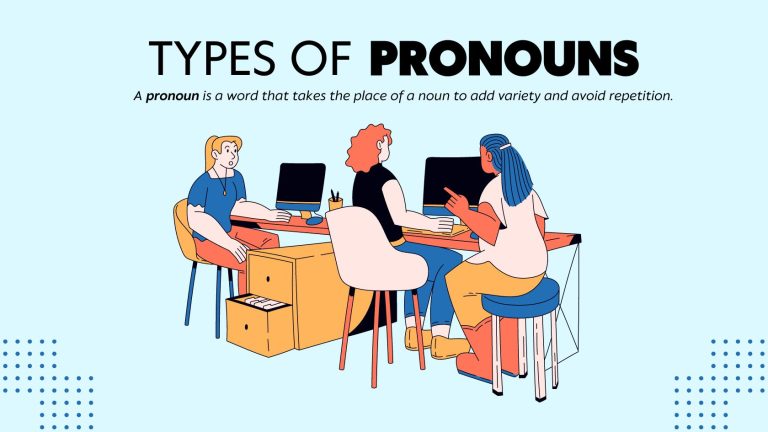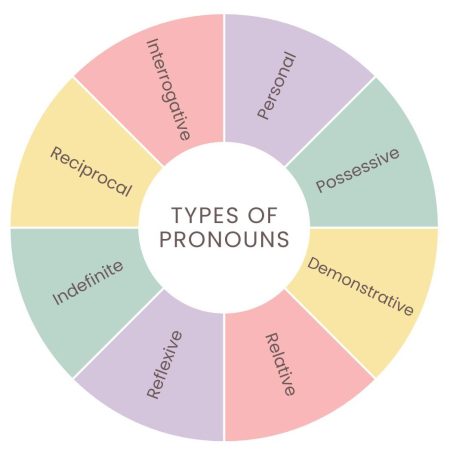8 Types of Pronouns

1. Personal Pronouns
Personal pronouns are words we use instead of names to talk about people (including ourselves) and things. Typically, they represent people, places, or things.
They can change based on who we’re talking about. For example, the first person is “I” or “we”. The second person is “you”. Finally, the third person is “he,” “she,” “it,”, or “they”.
They make sentences smoother because we don’t have to keep repeating names. For example, instead of saying “Maria likes the car,” we say, “She likes the car.” It’s also common in reported speech.
Personal pronouns: I, me, you, he, him, she, her, it, we, us, they, them.
Example: She loves to read books in her free time.
2. Possessive Pronouns
Possessive pronouns show who something belongs to without repeating the owner’s name. They replace the owner’s name and the thing owned, avoiding repetition.
These pronouns change to reflect whose item we’re talking about. For instance, it could be “mine,” “yours,” “his,” “hers,” “its,” “ours,” and “theirs.” So, instead of saying “That is Sarah’s book,” we can say, “That book is hers.”
Possessive pronouns: Mine, yours, his, hers, ours, theirs.
Example: Her cat is much cuter than mine.
3. Demonstrative Pronouns
Demonstrative pronouns point out specific things or people. It’s often in relation to the speaker’s location or the conversational context. They include “this,” “that,” “these,” and “those.”
“This” and “these” refer to items close to the speaker, with “this” for singular and “these” for plural. On the other hand, “that” and “those” are items farther away, again with “that” for singular and “those” for plural.
For example, if you’re holding a book, you might say, “This is interesting”. But if you’re pointing to a book across the room, you’d say, “That looks interesting.”
Demonstrative pronouns: This, that, these, those.
Example: This is the book that I was talking about.
4. Relative Pronouns
Relative pronouns connect one part of the sentence to another. They include pronouns like “who,” “whom,” “whose,” “which,” and “that.”
These pronouns help us combine sentences or ideas smoothly. Take the phrase “The person is a teacher. The person lives next door.” Instead, we can say, “The person who lives next door is a teacher.”
“Who” relates to people, “which” to animals or things, and “that” can refer to both. “Whom” is used for the object of the verb, and “whose” shows possession.
Relative pronouns: Who, whom, which, that, whose.
Example: The person who won the competition is my best friend.
5. Reflexive Pronouns
We use reflexive pronouns to reflect back to others or something else. They end in “-self” for singular (like “myself,” “yourself,” “itself”). For plural, they end with “-selves” (like “ourselves,” “yourselves,” and “themselves”).
These pronouns indicate that the action is done by and to the same entity. For example, instead of just saying “I did it,” saying “I did it myself” puts more emphasis on the fact that you did the action without anyone else’s help.
We use reflexive pronouns when the subject and the object of a sentence are the same person or thing. They help clarify who is performing the action and who is affected by it.
Reflexive pronouns: Myself, Yourself, Himself, Herself, Itself, Ourselves, Yourselves, Themselves.
Example: The cat groomed itself.
6. Indefinite Pronouns
Indefinite pronouns refer to one or more unspecified objects, beings, or places. Common indefinite pronouns include “anyone,” “anything,” “everyone,” “no one,” “nothing,” “someone,” “something,” “few,” “many,” and “several.”
We call them “indefinite” because they don’t point to a specific person or thing. We can use these pronouns for people (“Someone called you”) or things (“Nothing was left”).
This type of pronoun is useful for speaking in general terms or when we don’t know the identity of the noun. They can make our sentences either universally applicable or deliberately vague.
Indefinite pronouns: Anybody, Nobody, Each, Either, Neither, Someone, None, One, Several, Few.
Example: Someone knocked on the door.
7. Reciprocal Pronouns
Reciprocal pronouns express mutual action. We use them when two or more subjects perform the same action towards each other. The most common reciprocal pronouns include “each other” and “one another.”
For example, “The twins hugged each other” means that both twins were hugging, and the action was shared between them. In this case, the reciprocal pronoun shows a mutual action between both twins.
Reciprocal pronouns simplify how we express mutual actions or feelings. It makes it clear that everyone involved is both giving and receiving the action.
Reciprocal pronouns: Each other, one another.
Example: They helped each other with their homework.
8. Interrogative Pronouns
Interrogative pronouns are for asking questions about people or things. These pronouns include “who,” “whom,” “whose,” “which,” and “what.”
Here are some examples of interrogative pronouns. “Who called me?” asks for the identity of a person. “Whose is this?” inquires about ownership, “Which is faster?” compares items. Finally, “What happened?” seeks information about a situation.
Interrogative pronouns help us seek specific information by replacing the noun we’re inquiring about. We use interrogative pronouns for framing questions more directly.
Interrogative Pronouns: Who, Whom, Whose, Which, What.
Example: Whose book is this?
Types of Pronouns
Pronouns are handy words that help us talk about people, things, and places without repeating them. There are many types, each with its own job.
We hope you’ve learned about pronoun classification. Do you have any questions? Please let us know in our comment section below.

